Python Data Structures (original) (raw)
**Data Structures are a way of organizing data so that it can be accessed more efficiently depending upon the situation. Data Structures are fundamentals of any programming language around which a program is built. Python helps to learn the fundamental of these data structures in a simpler way as compared to other programming languages.

In this article, we will discuss the Data Structures in the Python Programming Language and how they are related to some specific Python Data Types. We will discuss all the in-built data structures like list tuples, dictionaries, etc. as well as some advanced data structures like trees, graphs, etc.
Lists
Python Lists are just like the arrays, declared in other languages which is an ordered collection of data. It is very flexible as the items in a list do not need to be of the same type.
The implementation of Python List is similar to Vectors in C++ or ArrayList in JAVA. The costly operation is inserting or deleting the element from the beginning of the List as all the elements are needed to be shifted. Insertion and deletion at the end of the list can also become costly in the case where the preallocated memory becomes full.
We can create a list in python as shown below.
**Example: Creating Python List
Python `
List = [1, 2, 3, "GFG", 2.3] print(List)
`
Output
[1, 2, 3, 'GFG', 2.3]
List elements can be accessed by the assigned index. In python starting index of the list, sequence is 0 and the ending index is (if N elements are there) N-1.
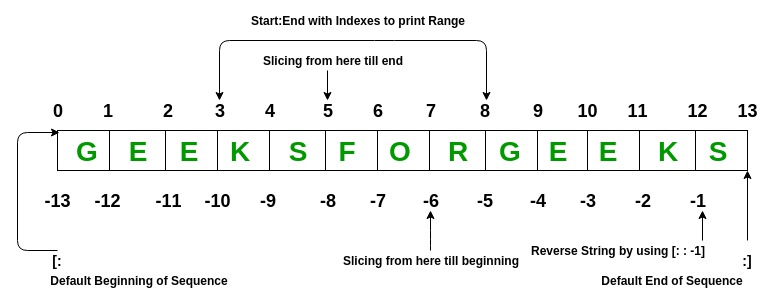
**Example: Python List Operations
Python `
Creating a List with
the use of multiple values
List = ["Geeks", "For", "Geeks"] print("\nList containing multiple values: ") print(List)
Creating a Multi-Dimensional List
(By Nesting a list inside a List)
List2 = [['Geeks', 'For'], ['Geeks']] print("\nMulti-Dimensional List: ") print(List2)
accessing a element from the
list using index number
print("Accessing element from the list")
print(List[0])
print(List[2])
accessing a element using
negative indexing
print("Accessing element using negative indexing")
print the last element of list
print(List[-1])
print the third last element of list
print(List[-3])
`
Output
List containing multiple values: ['Geeks', 'For', 'Geeks']
Multi-Dimensional List: [['Geeks', 'For'], ['Geeks']] Accessing element from the list Geeks Geeks Accessing element using negative indexing Geeks Geeks
Dictionary
Python dictionary is like hash tables in any other language with the time complexity of O(1). It is an unordered collection of data values, used to store data values like a map, which, unlike other Data Types that hold only a single value as an element, Dictionary holds the key:value pair. Key-value is provided in the dictionary to make it more optimized.
Indexing of Python Dictionary is done with the help of keys. These are of any hashable type i.e. an object whose can never change like strings, numbers, tuples, etc. We can create a dictionary by using curly braces ({}) or dictionary comprehension.
**Example: Python Dictionary Operations
Python `
Creating a Dictionary
Dict = {'Name': 'Geeks', 1: [1, 2, 3, 4]} print("Creating Dictionary: ") print(Dict)
accessing a element using key
print("Accessing a element using key:") print(Dict['Name'])
accessing a element using get()
method
print("Accessing a element using get:") print(Dict.get(1))
creation using Dictionary comprehension
myDict = {x: x**2 for x in [1,2,3,4,5]} print(myDict)
`
Output
Creating Dictionary: {'Name': 'Geeks', 1: [1, 2, 3, 4]} Accessing a element using key: Geeks Accessing a element using get: [1, 2, 3, 4] {1: 1, 2: 4, 3: 9, 4: 16, 5: 25}
Tuple
Python Tuple is a collection of Python objects much like a list but Tuples are immutable in nature i.e. the elements in the tuple cannot be added or removed once created. Just like a List, a Tuple can also contain elements of various types.
In Python, tuples are created by placing a sequence of values separated by ‘comma’ with or without the use of parentheses for grouping of the data sequence.
**Note: Tuples can also be created with a single element, but it is a bit tricky. Having one element in the parentheses is not sufficient, there must be a trailing ‘comma’ to make it a tuple.
Example: Python Tuple Operations
Python `
Creating a Tuple with
the use of Strings
Tuple = ('Geeks', 'For') print("\nTuple with the use of String: ") print(Tuple)
Creating a Tuple with
the use of list
list1 = [1, 2, 4, 5, 6] print("\nTuple using List: ") Tuple = tuple(list1)
Accessing element using indexing
print("First element of tuple") print(Tuple[0])
Accessing element from last
negative indexing
print("\nLast element of tuple") print(Tuple[-1])
print("\nThird last element of tuple") print(Tuple[-3])
`
Output
Tuple with the use of String: ('Geeks', 'For')
Tuple using List: First element of tuple 1
Last element of tuple 6
Third last element of tuple 4
Set
Python Set is an unordered collection of data that is mutable and does not allow any duplicate element. Sets are basically used to include membership testing and eliminating duplicate entries. The data structure used in this is Hashing, a popular technique to perform insertion, deletion, and traversal in O(1) on average.
If Multiple values are present at the same index position, then the value is appended to that index position, to form a Linked List. In, CPython Sets are implemented using a dictionary with dummy variables, where key beings the members set with greater optimizations to the time complexity.
**Set Implementation:
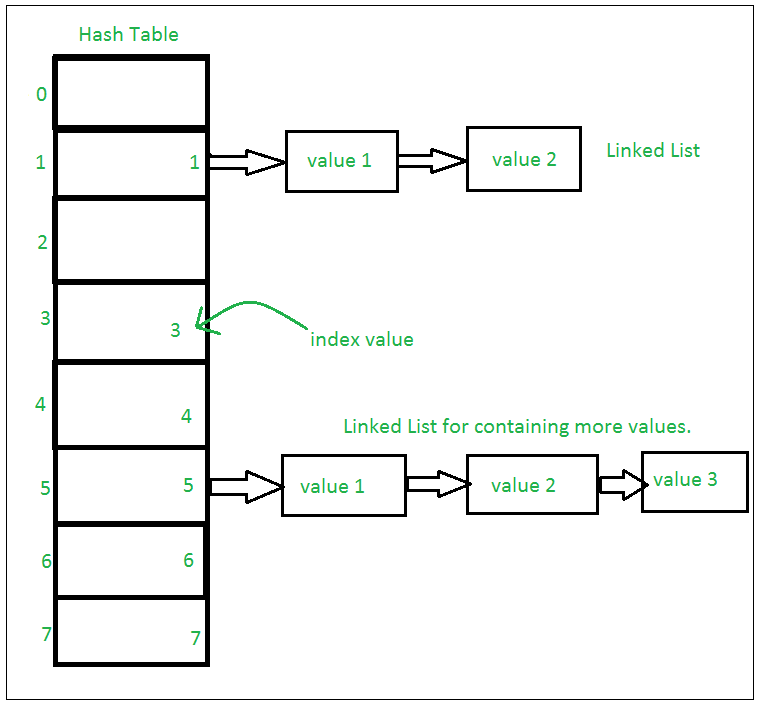
**Sets with Numerous operations on a single HashTable:
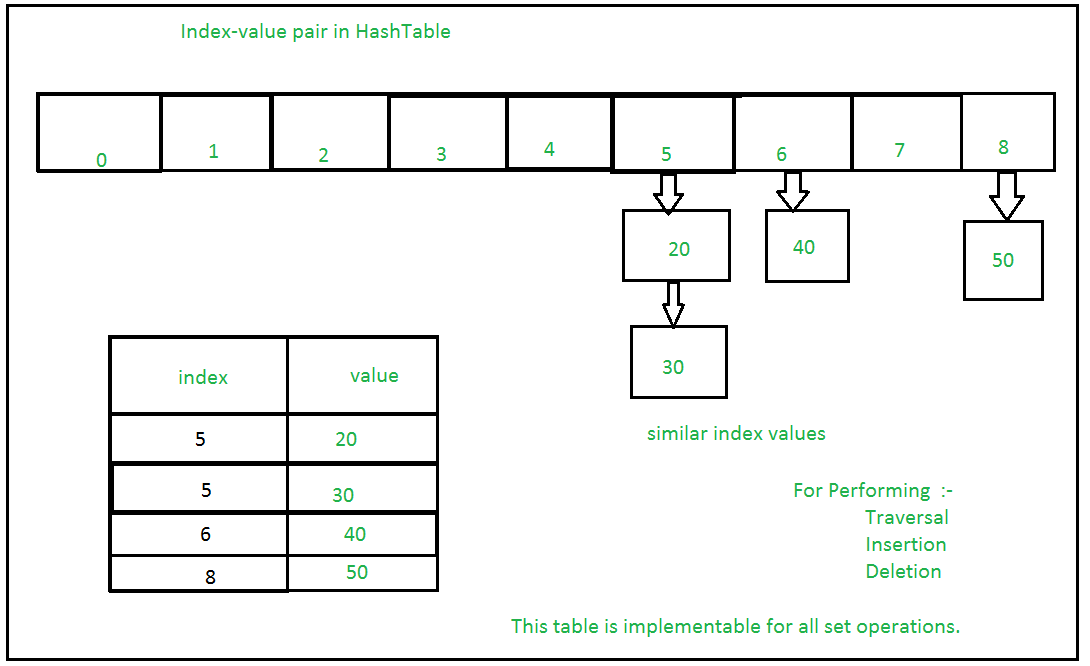
Example: Python Set Operations
Python `
Creating a Set with
a mixed type of values
(Having numbers and strings)
Set = set([1, 2, 'Geeks', 4, 'For', 6, 'Geeks']) print("\nSet with the use of Mixed Values") print(Set)
Accessing element using
for loop
print("\nElements of set: ") for i in Set: print(i, end =" ") print()
Checking the element
using in keyword
print("Geeks" in Set)
`
Output
Set with the use of Mixed Values {1, 2, 'Geeks', 4, 6, 'For'}
Elements of set: 1 2 Geeks 4 6 For True
Frozen Sets
Frozen sets in Python are immutable objects that only support methods and operators that produce a result without affecting the frozen set or sets to which they are applied. While elements of a set can be modified at any time, elements of the frozen set remain the same after creation.
If no parameters are passed, it returns an empty frozenset.
Python `
Same as {"a", "b","c"}
normal_set = set(["a", "b","c"])
print("Normal Set") print(normal_set)
A frozen set
frozen_set = frozenset(["e", "f", "g"])
print("\nFrozen Set") print(frozen_set)
Uncommenting below line would cause error as
we are trying to add element to a frozen set
frozen_set.add("h")
`
Output
Normal Set {'a', 'c', 'b'}
Frozen Set frozenset({'g', 'e', 'f'})
String
Python Strings are arrays of bytes representing Unicode characters. In simpler terms, a string is an immutable array of characters. Python does not have a character data type, a single character is simply a string with a length of 1.
**Note: As strings are immutable, modifying a string will result in creating a new copy.
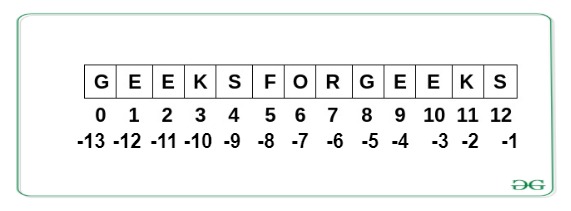
Example: Python Strings Operations
Python `
String = "Welcome to GeeksForGeeks" print("Creating String: ") print(String)
Printing First character
print("\nFirst character of String is: ") print(String[0])
Printing Last character
print("\nLast character of String is: ") print(String[-1])
`
Output
Creating String: Welcome to GeeksForGeeks
First character of String is: W
Last character of String is: s
Bytearray
Python Bytearray gives a mutable sequence of integers in the range 0 <= x < 256.
Example: Python Bytearray Operations
Python `
Creating bytearray
a = bytearray((12, 8, 25, 2)) print("Creating Bytearray:") print(a)
accessing elements
print("\nAccessing Elements:", a[1])
modifying elements
a[1] = 3 print("\nAfter Modifying:") print(a)
Appending elements
a.append(30) print("\nAfter Adding Elements:") print(a)
`
Output
Creating Bytearray: bytearray(b'\x0c\x08\x19\x02')
Accessing Elements: 8
After Modifying: bytearray(b'\x0c\x03\x19\x02')
After Adding Elements: bytearray(b'\x0c\x03\x19\x02\x1e')
Till now we have studied all the data structures that come built-in into core Python. Now let dive more deep into Python and see the collections module that provides some containers that are useful in many cases and provide more features than the above-defined functions.
Collections Module
Python collection module was introduced to improve the functionality of the built-in datatypes. It provides various containers let's see each one of them in detail.
Counters
A counter is a sub-class of the dictionary. It is used to keep the count of the elements in an iterable in the form of an unordered dictionary where the key represents the element in the iterable and value represents the count of that element in the iterable. This is equivalent to a bag or multiset of other languages.
Example: Python Counter Operations
Python `
from collections import Counter
With sequence of items
print(Counter(['B','B','A','B','C','A','B','B','A','C']))
with dictionary
count = Counter({'A':3, 'B':5, 'C':2}) print(count)
count.update(['A', 1]) print(count)
`
Output
Counter({'B': 5, 'A': 3, 'C': 2}) Counter({'B': 5, 'A': 3, 'C': 2}) Counter({'B': 5, 'A': 4, 'C': 2, 1: 1})
OrderedDict
An OrderedDict is also a sub-class of dictionary but unlike a dictionary, it remembers the order in which the keys were inserted.
Example: Python OrderedDict Operations
Python `
from collections import OrderedDict
print("Before deleting:\n") od = OrderedDict() od['a'] = 1 od['b'] = 2 od['c'] = 3 od['d'] = 4
for key, value in od.items(): print(key, value)
print("\nAfter deleting:\n") od.pop('c') for key, value in od.items(): print(key, value)
print("\nAfter re-inserting:\n") od['c'] = 3 for key, value in od.items(): print(key, value)
`
Output
Before deleting:
a 1 b 2 c 3 d 4
After deleting:
a 1 b 2 d 4
After re-inserting:
a 1 b 2 d 4 c 3
DefaultDict
DefaultDict is used to provide some default values for the key that does not exist and never raises a KeyError. Its objects can be initialized using DefaultDict() method by passing the data type as an argument.
**Note: default_factory is a function that provides the default value for the dictionary created. If this parameter is absent then the KeyError is raised.
Example: Python DefaultDict Operations
Python `
from collections import defaultdict
Defining the dict
d = defaultdict(int)
L = [1, 2, 3, 4, 2, 4, 1, 2]
Iterate through the list
for keeping the count
for i in L:
# The default value is 0
# so there is no need to
# enter the key first
d[i] += 1
print(d)
`
Output
defaultdict(<class 'int'>, {1: 2, 2: 3, 3: 1, 4: 2})
ChainMap
A ChainMap encapsulates many dictionaries into a single unit and returns a list of dictionaries. When a key is needed to be found then all the dictionaries are searched one by one until the key is found.
Example: Python ChainMap Operations
Python `
from collections import ChainMap
d1 = {'a': 1, 'b': 2} d2 = {'c': 3, 'd': 4} d3 = {'e': 5, 'f': 6}
Defining the chainmap
c = ChainMap(d1, d2, d3) print(c)
print(c['a']) print(c['g'])
`
**Output
ChainMap({'a': 1, 'b': 2}, {'c': 3, 'd': 4}, {'e': 5, 'f': 6}) 1
KeyError: 'g'
NamedTuple
A NamedTuple returns a tuple object with names for each position which the ordinary tuples lack. For example, consider a tuple names student where the first element represents fname, second represents lname and the third element represents the DOB. Suppose for calling fname instead of remembering the index position you can actually call the element by using the fname argument, then it will be really easy for accessing tuples element. This functionality is provided by the NamedTuple.
Example: Python NamedTuple Operations
Python `
from collections import namedtuple
Declaring namedtuple()
Student = namedtuple('Student',['name','age','DOB'])
Adding values
S = Student('Nandini','19','2541997')
Access using index
print ("The Student age using index is : ",end ="") print (S[1])
Access using name
print ("The Student name using keyname is : ",end ="") print (S.name)
`
Output
The Student age using index is : 19 The Student name using keyname is : Nandini
Deque
Deque (Doubly Ended Queue) is the optimized list for quicker append and pop operations from both sides of the container. It provides O(1) time complexity for append and pop operations as compared to the list with O(n) time complexity.
Python Deque is implemented using doubly linked lists therefore the performance for randomly accessing the elements is O(n).
Example: Python Deque Operations
Python `
importing "collections" for deque operations
import collections
initializing deque
de = collections.deque([1,2,3])
using append() to insert element at right end
inserts 4 at the end of deque
de.append(4)
printing modified deque
print("The deque after appending at right is : ") print(de)
using appendleft() to insert element at left end
inserts 6 at the beginning of deque
de.appendleft(6)
printing modified deque
print("The deque after appending at left is : ") print(de)
using pop() to delete element from right end
deletes 4 from the right end of deque
de.pop()
printing modified deque
print("The deque after deleting from right is : ") print(de)
using popleft() to delete element from left end
deletes 6 from the left end of deque
de.popleft()
printing modified deque
print("The deque after deleting from left is : ") print(de)
`
Output
The deque after appending at right is : deque([1, 2, 3, 4]) The deque after appending at left is : deque([6, 1, 2, 3, 4]) The deque after deleting from right is : deque([6, 1, 2, 3]) The deque after deleting from left is : deque([1, 2, 3])
UserDict
UserDict is a dictionary-like container that acts as a wrapper around the dictionary objects. This container is used when someone wants to create their own dictionary with some modified or new functionality.
Example: Python UserDict
Python `
from collections import UserDict
Creating a Dictionary where
deletion is not allowed
class MyDict(UserDict):
# Function to stop deletion
# from dictionary
def __del__(self):
raise RuntimeError("Deletion not allowed")
# Function to stop pop from
# dictionary
def pop(self, s = None):
raise RuntimeError("Deletion not allowed")
# Function to stop popitem
# from Dictionary
def popitem(self, s = None):
raise RuntimeError("Deletion not allowed")Driver's code
d = MyDict({'a':1, 'b': 2, 'c': 3})
print("Original Dictionary") print(d)
d.pop(1)
`
**Output
Original Dictionary {'a': 1, 'b': 2, 'c': 3}
RuntimeError: Deletion not allowed
UserList
UserList is a list-like container that acts as a wrapper around the list objects. This is useful when someone wants to create their own list with some modified or additional functionality.
Examples: Python UserList
Python `
Python program to demonstrate
userlist
from collections import UserList
Creating a List where
deletion is not allowed
class MyList(UserList):
# Function to stop deletion
# from List
def remove(self, s = None):
raise RuntimeError("Deletion not allowed")
# Function to stop pop from
# List
def pop(self, s = None):
raise RuntimeError("Deletion not allowed")Driver's code
L = MyList([1, 2, 3, 4])
print("Original List") print(L)
Inserting to List"
L.append(5) print("After Insertion") print(L)
Deleting From List
L.remove()
`
**Output
Original List [1, 2, 3, 4] After Insertion [1, 2, 3, 4, 5]
RuntimeError: Deletion not allowed
UserString
UserString is a string-like container and just like UserDict and UserList, it acts as a wrapper around string objects. It is used when someone wants to create their own strings with some modified or additional functionality.
Example: Python UserString
Python `
from collections import UserString
Creating a Mutable String
class Mystring(UserString):
# Function to append to
# string
def append(self, s):
self.data += s
# Function to remove from
# string
def remove(self, s):
self.data = self.data.replace(s, "")Driver's code
s1 = Mystring("Geeks") print("Original String:", s1.data)
Appending to string
s1.append("s") print("String After Appending:", s1.data)
Removing from string
s1.remove("e") print("String after Removing:", s1.data)
`
Output
Original String: Geeks String After Appending: Geekss String after Removing: Gkss
Now after studying all the data structures let's see some advanced data structures such as stack, queue, graph, linked list, etc. that can be used in Python Language.
Linked List
A linked list is a linear data structure, in which the elements are not stored at contiguous memory locations. The elements in a linked list are linked using pointers as shown in the below image:

A linked list is represented by a pointer to the first node of the linked list. The first node is called the head. If the linked list is empty, then the value of the head is NULL. Each node in a list consists of at least two parts:
- Data
- Pointer (Or Reference) to the next node
Example: Defining Linked List in Python
Python `
Node class
class Node:
# Function to initialize the node object
def __init__(self, data):
self.data = data # Assign data
self.next = None # Initialize
# next as nullLinked List class
class LinkedList:
# Function to initialize the Linked
# List object
def __init__(self):
self.head = None`
Let us create a simple linked list with 3 nodes.
Python `
A simple Python program to introduce a linked list
Node class
class Node:
# Function to initialise the node object
def __init__(self, data):
self.data = data # Assign data
self.next = None # Initialize next as nullLinked List class contains a Node object
class LinkedList:
# Function to initialize head
def __init__(self):
self.head = NoneCode execution starts here
if name=='main':
# Start with the empty list
list = LinkedList()
list.head = Node(1)
second = Node(2)
third = Node(3)
'''
Three nodes have been created.
We have references to these three blocks as head,
second and third
list.head second third
| | |
| | |
+----+------+ +----+------+ +----+------+
| 1 | None | | 2 | None | | 3 | None |
+----+------+ +----+------+ +----+------+
'''
list.head.next = second; # Link first node with second
'''
Now next of first Node refers to second. So they
both are linked.
list.head second third
| | |
| | |
+----+------+ +----+------+ +----+------+
| 1 | o-------->| 2 | null | | 3 | null |
+----+------+ +----+------+ +----+------+
'''
second.next = third; # Link second node with the third node
'''
Now next of second Node refers to third. So all three
nodes are linked.
list.head second third
| | |
| | |
+----+------+ +----+------+ +----+------+
| 1 | o-------->| 2 | o-------->| 3 | null |
+----+------+ +----+------+ +----+------+
'''`
Linked List Traversal
In the previous program, we have created a simple linked list with three nodes. Let us traverse the created list and print the data of each node. For traversal, let us write a general-purpose function printList() that prints any given list.
Python `
A simple Python program for traversal of a linked list
Node class
class Node:
# Function to initialise the node object
def __init__(self, data):
self.data = data # Assign data
self.next = None # Initialize next as nullLinked List class contains a Node object
class LinkedList:
# Function to initialize head
def __init__(self):
self.head = None
# This function prints contents of linked list
# starting from head
def printList(self):
temp = self.head
while (temp):
print (temp.data)
temp = temp.nextCode execution starts here
if name=='main':
# Start with the empty list
list = LinkedList()
list.head = Node(1)
second = Node(2)
third = Node(3)
list.head.next = second; # Link first node with second
second.next = third; # Link second node with the third node
list.printList()`
Stack
A stack is a linear data structure that stores items in a Last-In/First-Out (LIFO) or First-In/Last-Out (FILO) manner. In stack, a new element is added at one end and an element is removed from that end only. The insert and delete operations are often called push and pop.
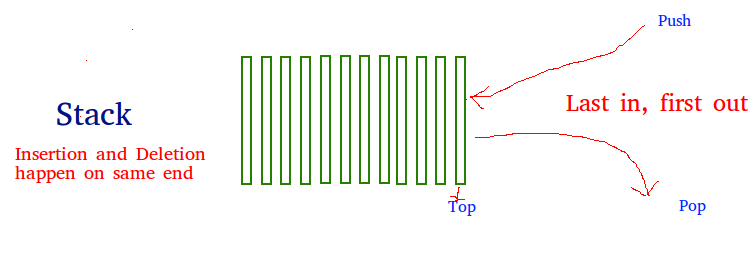
The functions associated with stack are:
- **empty() – Returns whether the stack is empty – Time Complexity: O(1)
- **size() – Returns the size of the stack – Time Complexity: O(1)
- **top() – Returns a reference to the topmost element of the stack – Time Complexity: O(1)
- **push(a) – Inserts the element ‘a’ at the top of the stack – Time Complexity: O(1)
- **pop() – Deletes the topmost element of the stack – Time Complexity: O(1)
Python Stack Implementation
Stack in Python can be implemented using the following ways:
- list
- Collections.deque
- queue.LifoQueue
**Implementation using List
Python’s built-in data structure list can be used as a stack. Instead of push(), append() is used to add elements to the top of the stack while pop() removes the element in LIFO order.
Python `
stack = []
append() function to push
element in the stack
stack.append('g') stack.append('f') stack.append('g')
print('Initial stack') print(stack)
pop() function to pop
element from stack in
LIFO order
print('\nElements popped from stack:') print(stack.pop()) print(stack.pop()) print(stack.pop())
print('\nStack after elements are popped:') print(stack)
uncommenting print(stack.pop())
will cause an IndexError
as the stack is now empty
`
Output
Initial stack ['g', 'f', 'g']
Elements popped from stack: g f g
Stack after elements are popped: []
**Implementation using collections.deque:
Python stack can be implemented using the deque class from the collections module. Deque is preferred over the list in the cases where we need quicker append and pop operations from both the ends of the container, as deque provides an O(1) time complexity for append and pop operations as compared to list which provides O(n) time complexity.
Python `
from collections import deque
stack = deque()
append() function to push
element in the stack
stack.append('g') stack.append('f') stack.append('g')
print('Initial stack:') print(stack)
pop() function to pop
element from stack in
LIFO order
print('\nElements popped from stack:') print(stack.pop()) print(stack.pop()) print(stack.pop())
print('\nStack after elements are popped:') print(stack)
uncommenting print(stack.pop())
will cause an IndexError
as the stack is now empty
`
Output
Initial stack: deque(['g', 'f', 'g'])
Elements popped from stack: g f g
Stack after elements are popped: deque([])
**Implementation using queue module
The queue module also has a LIFO Queue, which is basically a Stack. Data is inserted into Queue using the put() function and get() takes data out from the Queue.
Python `
from queue import LifoQueue
Initializing a stack
stack = LifoQueue(maxsize = 3)
qsize() show the number of elements
in the stack
print(stack.qsize())
put() function to push
element in the stack
stack.put('g') stack.put('f') stack.put('g')
print("Full: ", stack.full()) print("Size: ", stack.qsize())
get() function to pop
element from stack in
LIFO order
print('\nElements popped from the stack') print(stack.get()) print(stack.get()) print(stack.get())
print("\nEmpty: ", stack.empty())
`
Output
0 Full: True Size: 3
Elements popped from the stack g f g
Empty: True
Queue
As a stack, the queue is a linear data structure that stores items in a First In First Out (FIFO) manner. With a queue, the least recently added item is removed first. A good example of the queue is any queue of consumers for a resource where the consumer that came first is served first.

Operations associated with queue are:
- **Enqueue: Adds an item to the queue. If the queue is full, then it is said to be an Overflow condition – Time Complexity: O(1)
- **Dequeue: Removes an item from the queue. The items are popped in the same order in which they are pushed. If the queue is empty, then it is said to be an Underflow condition – Time Complexity: O(1)
- **Front: Get the front item from queue – Time Complexity: O(1)
- **Rear: Get the last item from queue – Time Complexity: O(1)
Python queue Implementation
Queue in Python can be implemented in the following ways:
- list
- collections.deque
- queue.Queue
**Implementation using list
Instead of enqueue() and dequeue(), append() and pop() function is used.
Python `
Initializing a queue
queue = []
Adding elements to the queue
queue.append('g') queue.append('f') queue.append('g')
print("Initial queue") print(queue)
Removing elements from the queue
print("\nElements dequeued from queue") print(queue.pop(0)) print(queue.pop(0)) print(queue.pop(0))
print("\nQueue after removing elements") print(queue)
Uncommenting print(queue.pop(0))
will raise and IndexError
as the queue is now empty
`
Output
Initial queue ['g', 'f', 'g']
Elements dequeued from queue g f g
Queue after removing elements []
**Implementation using collections.deque
Deque is preferred over the list in the cases where we need quicker append and pop operations from both the ends of the container, as deque provides an O(1) time complexity for append and pop operations as compared to list which provides O(n) time complexity.
Python `
from collections import deque
Initializing a queue
q = deque()
Adding elements to a queue
q.append('g') q.append('f') q.append('g')
print("Initial queue") print(q)
Removing elements from a queue
print("\nElements dequeued from the queue") print(q.popleft()) print(q.popleft()) print(q.popleft())
print("\nQueue after removing elements") print(q)
Uncommenting q.popleft()
will raise an IndexError
as queue is now empty
`
Output
Initial queue deque(['g', 'f', 'g'])
Elements dequeued from the queue g f g
Queue after removing elements deque([])
**Implementation using the queue.Queue
queue.Queue(maxsize) initializes a variable to a maximum size of maxsize. A maxsize of zero ‘0’ means an infinite queue. This Queue follows the FIFO rule.
Python `
from queue import Queue
Initializing a queue
q = Queue(maxsize = 3)
qsize() give the maxsize
of the Queue
print(q.qsize())
Adding of element to queue
q.put('g') q.put('f') q.put('g')
Return Boolean for Full
Queue
print("\nFull: ", q.full())
Removing element from queue
print("\nElements dequeued from the queue") print(q.get()) print(q.get()) print(q.get())
Return Boolean for Empty
Queue
print("\nEmpty: ", q.empty())
q.put(1) print("\nEmpty: ", q.empty()) print("Full: ", q.full())
This would result into Infinite
Loop as the Queue is empty.
print(q.get())
`
Output
0
Full: True
Elements dequeued from the queue g f g
Empty: True
Empty: False Full: False
Priority Queue
Priority Queues are abstract data structures where each data/value in the queue has a certain priority. For example, In airlines, baggage with the title “Business” or “First-class” arrives earlier than the rest. Priority Queue is an extension of the queue with the following properties.
- An element with high priority is dequeued before an element with low priority.
- If two elements have the same priority, they are served according to their order in the queue. Python `
A simple implementation of Priority Queue
using Queue.
class PriorityQueue(object): def init(self): self.queue = []
def __str__(self):
return ' '.join([str(i) for i in self.queue])
# for checking if the queue is empty
def isEmpty(self):
return len(self.queue) == 0
# for inserting an element in the queue
def insert(self, data):
self.queue.append(data)
# for popping an element based on Priority
def delete(self):
try:
max = 0
for i in range(len(self.queue)):
if self.queue[i] > self.queue[max]:
max = i
item = self.queue[max]
del self.queue[max]
return item
except IndexError:
print()
exit()if name == 'main':
myQueue = PriorityQueue()
myQueue.insert(12)
myQueue.insert(1)
myQueue.insert(14)
myQueue.insert(7)
print(myQueue)
while not myQueue.isEmpty():
print(myQueue.delete())
`
Output
12 1 14 7 14 12 7 1
Heap queue (or heapq)
heapq module in Python provides the heap data structure that is mainly used to represent a priority queue. The property of this data structure in Python is that each time the smallest heap element is popped(min-heap). Whenever elements are pushed or popped, heap structure is maintained. The heap[0] element also returns the smallest element each time.
It supports the extraction and insertion of the smallest element in the O(log n) times.
Python `
importing "heapq" to implement heap queue
import heapq
initializing list
li = [5, 7, 9, 1, 3]
using heapify to convert list into heap
heapq.heapify(li)
printing created heap
print ("The created heap is : ",end="") print (list(li))
using heappush() to push elements into heap
pushes 4
heapq.heappush(li,4)
printing modified heap
print ("The modified heap after push is : ",end="") print (list(li))
using heappop() to pop smallest element
print ("The popped and smallest element is : ",end="") print (heapq.heappop(li))
`
Output
The created heap is : [1, 3, 9, 7, 5] The modified heap after push is : [1, 3, 4, 7, 5, 9] The popped and smallest element is : 1
Binary Tree
A tree is a hierarchical data structure that looks like the below figure -
tree
----
j <-- root
/ \ f k
/ \
a h z <-- leaves
The topmost node of the tree is called the root whereas the bottommost nodes or the nodes with no children are called the leaf nodes. The nodes that are directly under a node are called its children and the nodes that are directly above something are called its parent.
A binary tree is a tree whose elements can have almost two children. Since each element in a binary tree can have only 2 children, we typically name them the left and right children. A Binary Tree node contains the following parts.
- Data
- Pointer to left child
- Pointer to the right child
Example: Defining Node Class
Python `
A Python class that represents an individual node
in a Binary Tree
class Node: def init(self,key): self.left = None self.right = None self.val = key
`
Now let's create a tree with 4 nodes in Python. Let's assume the tree structure looks like below -
tree
----
1 <-- root
/ \ 2 3
/
4
Example: Adding data to the tree
Python `
Python program to introduce Binary Tree
A class that represents an individual node in a
Binary Tree
class Node: def init(self,key): self.left = None self.right = None self.val = key
create root
root = Node(1)
''' following is the tree after above statement
1
/
None None'''
root.left = Node(2); root.right = Node(3);
''' 2 and 3 become left and right children of 1
1
/
2 3
/ \ /
None None None None'''
root.left.left = Node(4);
'''4 becomes left child of 2
1
/
2 3
/ \ /
4 None None None
/
None None'''
`
Tree Traversal
Trees can be traversed in different ways. Following are the generally used ways for traversing trees. Let us consider the below tree -
tree
----
1 <-- root
/ \ 2 3
/
4 5
**Depth First Traversals:
- Inorder (Left, Root, Right) : 4 2 5 1 3
- Preorder (Root, Left, Right) : 1 2 4 5 3
- Postorder (Left, Right, Root) : 4 5 2 3 1
**Algorithm Inorder(tree)
- Traverse the left subtree, i.e., call Inorder(left-subtree)
- Visit the root.
- Traverse the right subtree, i.e., call Inorder(right-subtree)
**Algorithm Preorder(tree)
- Visit the root.
- Traverse the left subtree, i.e., call Preorder(left-subtree)
- Traverse the right subtree, i.e., call Preorder(right-subtree)
**Algorithm Postorder(tree)
- Traverse the left subtree, i.e., call Postorder(left-subtree)
- Traverse the right subtree, i.e., call Postorder(right-subtree)
- Visit the root. Python `
Python program to for tree traversals
A class that represents an individual node in a
Binary Tree
class Node: def init(self, key): self.left = None self.right = None self.val = key
A function to do inorder tree traversal
def printInorder(root):
if root:
# First recur on left child
printInorder(root.left)
# then print the data of node
print(root.val),
# now recur on right child
printInorder(root.right)A function to do postorder tree traversal
def printPostorder(root):
if root:
# First recur on left child
printPostorder(root.left)
# the recur on right child
printPostorder(root.right)
# now print the data of node
print(root.val),A function to do preorder tree traversal
def printPreorder(root):
if root:
# First print the data of node
print(root.val),
# Then recur on left child
printPreorder(root.left)
# Finally recur on right child
printPreorder(root.right)Driver code
root = Node(1) root.left = Node(2) root.right = Node(3) root.left.left = Node(4) root.left.right = Node(5) print("Preorder traversal of binary tree is") printPreorder(root)
print("\nInorder traversal of binary tree is") printInorder(root)
print("\nPostorder traversal of binary tree is") printPostorder(root)
`
Output
Preorder traversal of binary tree is 1 2 4 5 3
Inorder traversal of binary tree is 4 2 5 1 3
Postorder traversal of binary tree is 4 5 2 3 1
Time Complexity - O(n)
**Breadth-First or Level Order Traversal
Level order traversal of a tree is breadth-first traversal for the tree. The level order traversal of the above tree is 1 2 3 4 5.
For each node, first, the node is visited and then its child nodes are put in a FIFO queue. Below is the algorithm for the same -
- Create an empty queue q
- temp_node = root /*start from root*/
- Loop while temp_node is not NULL
- print temp_node->data.
- Enqueue temp_node’s children (first left then right children) to q
- Dequeue a node from q Python `
Python program to print level
order traversal using Queue
A node structure
class Node:
# A utility function to create a new node
def __init__(self ,key):
self.data = key
self.left = None
self.right = NoneIterative Method to print the
height of a binary tree
def printLevelOrder(root):
# Base Case
if root is None:
return
# Create an empty queue
# for level order traversal
queue = []
# Enqueue Root and initialize height
queue.append(root)
while(len(queue) > 0):
# Print front of queue and
# remove it from queue
print (queue[0].data)
node = queue.pop(0)
# Enqueue left child
if node.left is not None:
queue.append(node.left)
# Enqueue right child
if node.right is not None:
queue.append(node.right)Driver Program to test above function
root = Node(1) root.left = Node(2) root.right = Node(3) root.left.left = Node(4) root.left.right = Node(5)
print ("Level Order Traversal of binary tree is -") printLevelOrder(root)
`
Output
Level Order Traversal of binary tree is - 1 2 3 4 5
Time Complexity: O(n)
Graph
A graph is a nonlinear data structure consisting of nodes and edges. The nodes are sometimes also referred to as vertices and the edges are lines or arcs that connect any two nodes in the graph. More formally a Graph can be defined as a Graph consisting of a finite set of vertices(or nodes) and a set of edges that connect a pair of nodes.
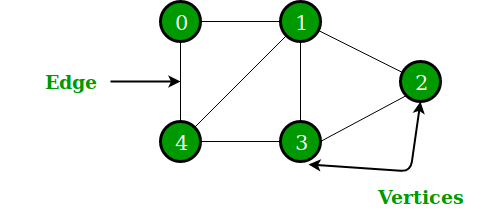
In the above Graph, the set of vertices V = {0,1,2,3,4} and the set of edges E = {01, 12, 23, 34, 04, 14, 13}.
The following two are the most commonly used representations of a graph.
- Adjacency Matrix
- Adjacency List
Adjacency Matrix
Adjacency Matrix is a 2D array of size V x V where V is the number of vertices in a graph. Let the 2D array be adj[][], a slot adj[i][j] = 1 indicates that there is an edge from vertex i to vertex j. The adjacency matrix for an undirected graph is always symmetric. Adjacency Matrix is also used to represent weighted graphs. If adj[i][j] = w, then there is an edge from vertex i to vertex j with weight w.
Python `
A simple representation of graph using Adjacency Matrix
class Graph: def init(self,numvertex): self.adjMatrix = [[-1]*numvertex for x in range(numvertex)] self.numvertex = numvertex self.vertices = {} self.verticeslist =[0]*numvertex
def set_vertex(self,vtx,id):
if 0<=vtx<=self.numvertex:
self.vertices[id] = vtx
self.verticeslist[vtx] = id
def set_edge(self,frm,to,cost=0):
frm = self.vertices[frm]
to = self.vertices[to]
self.adjMatrix[frm][to] = cost
# for directed graph do not add this
self.adjMatrix[to][frm] = cost
def get_vertex(self):
return self.verticeslist
def get_edges(self):
edges=[]
for i in range (self.numvertex):
for j in range (self.numvertex):
if (self.adjMatrix[i][j]!=-1):
edges.append((self.verticeslist[i],self.verticeslist[j],self.adjMatrix[i][j]))
return edges
def get_matrix(self):
return self.adjMatrixG =Graph(6) G.set_vertex(0,'a') G.set_vertex(1,'b') G.set_vertex(2,'c') G.set_vertex(3,'d') G.set_vertex(4,'e') G.set_vertex(5,'f') G.set_edge('a','e',10) G.set_edge('a','c',20) G.set_edge('c','b',30) G.set_edge('b','e',40) G.set_edge('e','d',50) G.set_edge('f','e',60)
print("Vertices of Graph") print(G.get_vertex())
print("Edges of Graph") print(G.get_edges())
print("Adjacency Matrix of Graph") print(G.get_matrix())
`
**Output
Vertices of Graph
['a', 'b', 'c', 'd', 'e', 'f']
Edges of Graph
[('a', 'c', 20), ('a', 'e', 10), ('b', 'c', 30), ('b', 'e', 40), ('c', 'a', 20), ('c', 'b', 30), ('d', 'e', 50), ('e', 'a', 10), ('e', 'b', 40), ('e', 'd', 50), ('e', 'f', 60), ('f', 'e', 60)]
Adjacency Matrix of Graph
[[-1, -1, 20, -1, 10, -1], [-1, -1, 30, -1, 40, -1], [20, 30, -1, -1, -1, -1], [-1, -1, -1, -1, 50, -1], [10, 40, -1, 50, -1, 60], [-1, -1, -1, -1, 60, -1]]
Adjacency List
An array of lists is used. The size of the array is equal to the number of vertices. Let the array be an array[]. An entry array[i] represents the list of vertices adjacent to the ith vertex. This representation can also be used to represent a weighted graph. The weights of edges can be represented as lists of pairs. Following is the adjacency list representation of the above graph.

Python `
A class to represent the adjacency list of the node
class AdjNode: def init(self, data): self.vertex = data self.next = None
A class to represent a graph. A graph
is the list of the adjacency lists.
Size of the array will be the no. of the
vertices "V"
class Graph: def init(self, vertices): self.V = vertices self.graph = [None] * self.V
# Function to add an edge in an undirected graph
def add_edge(self, src, dest):
# Adding the node to the source node
node = AdjNode(dest)
node.next = self.graph[src]
self.graph[src] = node
# Adding the source node to the destination as
# it is the undirected graph
node = AdjNode(src)
node.next = self.graph[dest]
self.graph[dest] = node
# Function to print the graph
def print_graph(self):
for i in range(self.V):
print("Adjacency list of vertex {}\n head".format(i), end="")
temp = self.graph[i]
while temp:
print(" -> {}".format(temp.vertex), end="")
temp = temp.next
print(" \n")Driver program to the above graph class
if name == "main": V = 5 graph = Graph(V) graph.add_edge(0, 1) graph.add_edge(0, 4) graph.add_edge(1, 2) graph.add_edge(1, 3) graph.add_edge(1, 4) graph.add_edge(2, 3) graph.add_edge(3, 4)
graph.print_graph()`
Output
Adjacency list of vertex 0 head -> 4 -> 1
Adjacency list of vertex 1 head -> 4 -> 3 -> 2 -> 0
Adjacency list of vertex 2 head -> 3 -> 1
Adjacency list of vertex 3 head -> 4 -> 2 -> 1
Adjacency list of vertex 4 head -> 3 -> 1 -> 0
Graph Traversal
**Breadth-First Search or BFS
Breadth-First Traversal for a graph is similar to Breadth-First Traversal of a tree. The only catch here is, unlike trees, graphs may contain cycles, so we may come to the same node again. To avoid processing a node more than once, we use a boolean visited array. For simplicity, it is assumed that all vertices are reachable from the starting vertex.
For example, in the following graph, we start traversal from vertex 2. When we come to vertex 0, we look for all adjacent vertices of it. 2 is also an adjacent vertex of 0. If we don’t mark visited vertices, then 2 will be processed again and it will become a non-terminating process. A Breadth-First Traversal of the following graph is 2, 0, 3, 1.
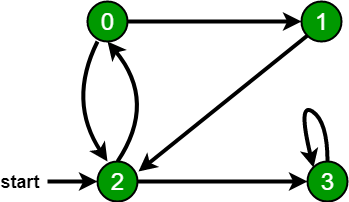
Python `
Python3 Program to print BFS traversal
from a given source vertex. BFS(int s)
traverses vertices reachable from s.
from collections import defaultdict
This class represents a directed graph
using adjacency list representation
class Graph:
# Constructor
def __init__(self):
# default dictionary to store graph
self.graph = defaultdict(list)
# function to add an edge to graph
def addEdge(self,u,v):
self.graph[u].append(v)
# Function to print a BFS of graph
def BFS(self, s):
# Mark all the vertices as not visited
visited = [False] * (max(self.graph) + 1)
# Create a queue for BFS
queue = []
# Mark the source node as
# visited and enqueue it
queue.append(s)
visited[s] = True
while queue:
# Dequeue a vertex from
# queue and print it
s = queue.pop(0)
print (s, end = " ")
# Get all adjacent vertices of the
# dequeued vertex s. If a adjacent
# has not been visited, then mark it
# visited and enqueue it
for i in self.graph[s]:
if visited[i] == False:
queue.append(i)
visited[i] = TrueDriver code
Create a graph given in
the above diagram
g = Graph() g.addEdge(0, 1) g.addEdge(0, 2) g.addEdge(1, 2) g.addEdge(2, 0) g.addEdge(2, 3) g.addEdge(3, 3)
print ("Following is Breadth First Traversal" " (starting from vertex 2)") g.BFS(2)
This code is contributed by Neelam Yadav
`
Output
Following is Breadth First Traversal (starting from vertex 2) 2 0 3 1
Time Complexity: O(V+E) where V is the number of vertices in the graph and E is the number of edges in the graph.
**Depth First Search or DFS
Depth First Traversal for a graph is similar to Depth First Traversal of a tree. The only catch here is, unlike trees, graphs may contain cycles, a node may be visited twice. To avoid processing a node more than once, use a boolean visited array.
**Algorithm:
- Create a recursive function that takes the index of the node and a visited array.
- Mark the current node as visited and print the node.
- Traverse all the adjacent and unmarked nodes and call the recursive function with the index of the adjacent node. Python `
Python3 program to print DFS traversal
from a given graph
from collections import defaultdict
This class represents a directed graph using
adjacency list representation
class Graph:
# Constructor
def __init__(self):
# default dictionary to store graph
self.graph = defaultdict(list)
# function to add an edge to graph
def addEdge(self, u, v):
self.graph[u].append(v)
# A function used by DFS
def DFSUtil(self, v, visited):
# Mark the current node as visited
# and print it
visited.add(v)
print(v, end=' ')
# Recur for all the vertices
# adjacent to this vertex
for neighbour in self.graph[v]:
if neighbour not in visited:
self.DFSUtil(neighbour, visited)
# The function to do DFS traversal. It uses
# recursive DFSUtil()
def DFS(self, v):
# Create a set to store visited vertices
visited = set()
# Call the recursive helper function
# to print DFS traversal
self.DFSUtil(v, visited)Driver code
Create a graph given
in the above diagram
g = Graph() g.addEdge(0, 1) g.addEdge(0, 2) g.addEdge(1, 2) g.addEdge(2, 0) g.addEdge(2, 3) g.addEdge(3, 3)
print("Following is DFS from (starting from vertex 2)") g.DFS(2)
`
Output
Following is DFS from (starting from vertex 2) 2 0 1 3
Time complexity: O(V + E), where V is the number of vertices and E is the number of edges in the graph.